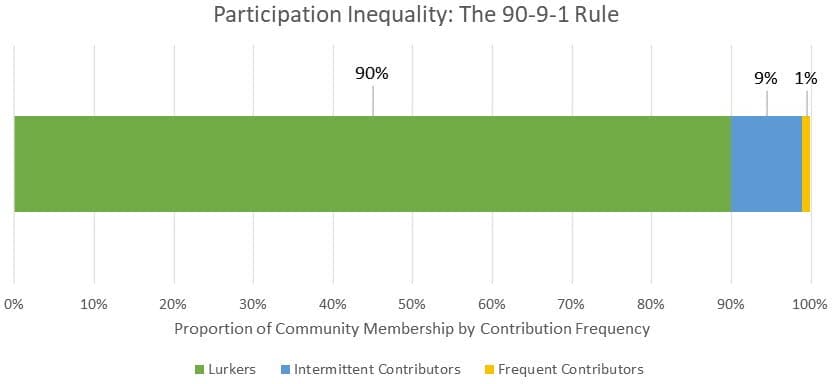How to Make Community Participation More Equal by Making Better Design Choices

Participation in your community will be unequal and inequitable. That’s because the insight that is co-produced by members through their investment of time and social capital is a public good. As such, it’s subject to the free rider problem. However, you can make participation more equal through well-designed reward systems that feature peer recognition.
Participation In Your Community Will be Unequal
Every large scale, multi-user, online community that has been studied since the 1990s has exhibited participation inequality. That is, a very small proportion of members make the vast majority of contributions. This phenomenon has been popularized as the 90-9-1 rule:

As a rule of thumb:
- 1% of members participate frequently and account for the majority of contributions.
- 9% of members contribute occasionally.
- 90% of members are “lurkers.” They read and observe but don’t contribute.
Participation inequality is problematic for at least two reasons:
- It leads to a biased understanding of the community, its goals, and its needs.
- It reflects a form of under-investment leading to under-performance.
You cannot eliminate participation inequality. However, you can make design choices to encourage more equitable participation.
The Source of Participation Inequality
A key “product” of a collaborative community is the insight that emerges from conversations and interactions among members. Such conversations require the voluntary investment of time and social capital, which is typically much more significant than the cost of membership. In essence, members co-produce the benefits of membership.
However, in the context of the community, the benefit derived from member contributions is a public good. That means everyone can share the benefit, but only contributors incur the cost. Invariably, that leads to free-riding, which manifests as participation inequality. In other words, not enough members contribute enough for the community to achieve its full potential. Eventually, many communities languish as a result.
Rewarding Contributions
Nevertheless, members are willing to invest their time and social capital if they perceive benefits from doing so. As a community host, you can reduce participation inequality by rewarding contributions. When doing so, keep a couple of things in mind:
- Cash isn’t the only currency that matters. Again, the true cost of membership is time and social capital (i.e. know-how and know-who). Recognition and preferential access to community resources, for example, might be worth more than a discounted membership.
- Members are the arbiters of value. Finding out what is valuable to them is crucial.
Research has yielded a number of guidelines for practitioners when designing reward systems:
- Recognition motivates members to increase their contributions and participation.
- Peer recognition matters more than recognition by the host.
- Don’t over-reward the most active members.
- Make it easy and natural to contribute and acknowledge the contributions of others.
The need to limit rewards to the most active contributors can seem a bit counter-intuitive. The reasons for doing so include the following:
- You can unwittingly encourage even greater participation inequality if some members accumulate ever-increasing visibility and prestige within your community.
- The efficacy of rewards is subject to diminishing returns. Rewarding first-time contributors is likely to yield more than rewarding frequent contributors.
- There is evidence that recipients of several endorsements or rewards may exhibit a form of moral licensing effect. That is, they may feel entitled to rest on the laurels of their past contributions.
Barnstars vs Badges
My takeaway from community researchers and practitioners is that peer-initiated awards like Wikipedia’s barnstars are more likely than host-initiated badges to encourage more—and more equitable—contributions to a community over time.
- Because they are initiated by members, barnstars reflect appreciation for contributions valued by members.
- Member recognition is a more powerful motivator than is host recognition.
- Barnstars are flexible in that they can represent different things to different people over time.
Barnstar-like systems complement, rather than replace, easy-to-use recognition systems such as likes and up-votes. Furthermore, barnstar awards can be bundled with other rewards such a (temporary) fee discounts or preferential access (e.g. membership on a steering committee).
Don’t Over-engineer Your Community
In any case, less is probably more. Continuing to reward active contributors is likely to yield diminishing returns and can even undermine your attempts to broaden participation in your community. More broadly, intervening in complex social systems can result in unintended consequences. Avoid the temptation to steer your community too aggressively.
Discussion Question
Should rewards have an expiration date? Might that mitigate the moral licensing effect?
Resources
The 90-9-1 Rule for Participation Inequality in Social Media and Online Communities
Experimental Study of Informal Rewards in Peer Production (PDF)
Field Experiments of Success-Breeds-Success Dynamics (PDF)
Engaging Voluntary Contributions in Online Communities: A Hidden Markov Model (PDF)
